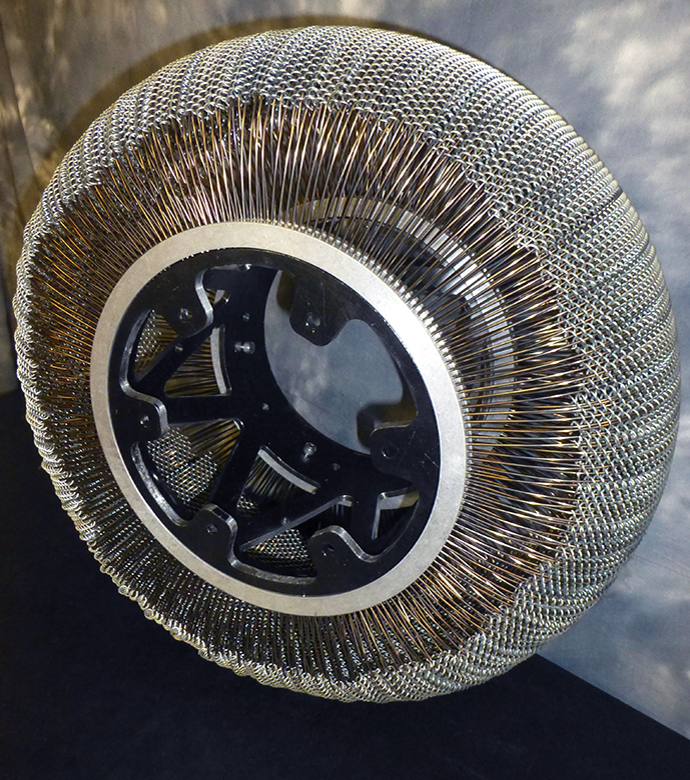La NASA ha desarrollado una rueda hueca, formada por un material con “memoria”, de manera que puede adaptarse a cualquier superficie sin importar el tipo de irregularidad, y volver a su estado natural. Esta innovación, llamada llanta superelástica, se desarrolló para futuras misiones a Marte, pero es una alternativa viable a los neumáticos en la Tierra. Esta tecnología representa la última evolución de Spring Tire, que fue inventada por la NASA – Glenn and Goodyear e inspirada en los neumáticos del vehículo lunar Apollo. El uso novedoso de aleaciones con memoria de forma son capaces de someterse a una gran tensión como componentes de soporte de carga, en lugar de los materiales elásticos típicos este diseño da como resultado un neumático que puede resistir una deformación excesiva sin daños permanentes.
 Innovators at NASA’s Glenn Research center have developed a game changing, non-pneumatic, compliant tire. This innovation, called the Superelastic Tire, was developed for future Mars missions, but is a viable alternative to pneumatic tires here on Earth. This technology represents the latest evolution of the Spring Tire which was invented by NASA Glenn and Goodyear, and inspired by the Apollo lunar tires. The novel use of shape memory alloys capable of undergoing high strain as load bearing components, instead of typical elastic materials, results in a tire that can withstand excessive deformation without permanent damage. Using shape memory alloy as radial stiffening elements can also increase the load carrying capacity of the tire. The Superelastic Tire offers traction equal or superior to conventional pneumatic tires and eliminates the possibility of puncture failures, thereby improving automobile safety. This tire design also eliminates the need for an inner frame which both simplifies and lightens the tire/wheel assembly.
Innovators at NASA’s Glenn Research center have developed a game changing, non-pneumatic, compliant tire. This innovation, called the Superelastic Tire, was developed for future Mars missions, but is a viable alternative to pneumatic tires here on Earth. This technology represents the latest evolution of the Spring Tire which was invented by NASA Glenn and Goodyear, and inspired by the Apollo lunar tires. The novel use of shape memory alloys capable of undergoing high strain as load bearing components, instead of typical elastic materials, results in a tire that can withstand excessive deformation without permanent damage. Using shape memory alloy as radial stiffening elements can also increase the load carrying capacity of the tire. The Superelastic Tire offers traction equal or superior to conventional pneumatic tires and eliminates the possibility of puncture failures, thereby improving automobile safety. This tire design also eliminates the need for an inner frame which both simplifies and lightens the tire/wheel assembly.- Safe: Eliminates the possibility of puncture failure
- Strong: Can withstand excessive deformation
- Robust: Can be configured for high traction on various terrains
- Simple: Eliminates the need for air
- Versatile: Tire stiffness can be designed to limit energy transferred to vehicle
- Lightweight: No inner frame needed for the tire/wheel assembly
- All-terrain vehicle tires
- Military vehicle tires
- Construction vehicle tires
- Automobile tires
- Heavy equipment tires
- Agricultural vehicle tires
- Aircraft tires
 This NASA Glenn innovation comprises a non-pneumatic, compliant tire utilizing shape memory alloys (mainly NiTi and its derivatives) as load bearing components. These shape memory alloys are capable of undergoing significant reversible strain (up to 10%), enabling the tire to withstand an order of magnitude more deformation than other non-pneumatic tires before undergoing permanent deformation. Commonly used elastic-plastic materials (e.g. spring steels, composites, etc.) can only be subjected to strains on the order of ~ 0.3-0.5% before yielding. Hence, the use of a NiTi shape memory alloy yields a superelastic tire that is virtually impervious to plastic deformation. In addition, the utilization of shape memory alloys provides enhanced control over the effective stiffness as a function of the deformation, providing increased design versatility. For instance, the Glenn Superelastic Tire can be made to soften with increased deflection, reducing the amount of energy transferred to the vehicle during high deformation events. In addition, the use of shape memory alloys in the form of radial stiffeners, as opposed to springs, provides even more load carrying potential and improved design flexibility. This type of compliant tire would allow for increased travel speeds in off-road applications.
This NASA Glenn innovation comprises a non-pneumatic, compliant tire utilizing shape memory alloys (mainly NiTi and its derivatives) as load bearing components. These shape memory alloys are capable of undergoing significant reversible strain (up to 10%), enabling the tire to withstand an order of magnitude more deformation than other non-pneumatic tires before undergoing permanent deformation. Commonly used elastic-plastic materials (e.g. spring steels, composites, etc.) can only be subjected to strains on the order of ~ 0.3-0.5% before yielding. Hence, the use of a NiTi shape memory alloy yields a superelastic tire that is virtually impervious to plastic deformation. In addition, the utilization of shape memory alloys provides enhanced control over the effective stiffness as a function of the deformation, providing increased design versatility. For instance, the Glenn Superelastic Tire can be made to soften with increased deflection, reducing the amount of energy transferred to the vehicle during high deformation events. In addition, the use of shape memory alloys in the form of radial stiffeners, as opposed to springs, provides even more load carrying potential and improved design flexibility. This type of compliant tire would allow for increased travel speeds in off-road applications.
Fuente: https://technology.nasa.gov

